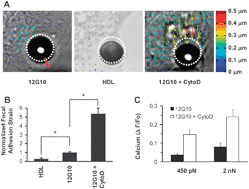Ultra-rapid activation of TRPV4 ion channels by mechanical forces applied to cell surface β1 integrins†
Abstract
Integrins are ubiquitous transmembrane mechanoreceptors that elicit changes in

Maintenance work is planned for Wednesday 1st May 2024 from 9:00am to 11:00am (BST).
During this time, the performance of our website may be affected - searches may run slowly and some pages may be temporarily unavailable. If this happens, please try refreshing your web browser or try waiting two to three minutes before trying again.
We apologise for any inconvenience this might cause and thank you for your patience.
* Corresponding authors
a
Vascular Biology Program, Departments of Medicine, Pathology and Surgery, Harvard Medical School and Children's Hospital, Boston, USA
E-mail:
don.ingber@wyss.harvard.edu
Fax: 617-432-7828
Tel: 617-432-7044
b Department of Integrative Medical Sciences, NEOUCOM, Rootstown, USA
c Department of Bioengineering, Imperial College London, London, UK
d Wyss Institute for Biologically Inspired Engineering at Harvard University, Boston, USA
e School of Engineering and Applied Sciences, Harvard University, Cambridge, USA
Integrins are ubiquitous transmembrane mechanoreceptors that elicit changes in

 Please wait while we load your content...
Something went wrong. Try again?
Please wait while we load your content...
Something went wrong. Try again?
 Fetching data from CrossRef.
Fetching data from CrossRef.
This may take some time to load.
Loading related content
